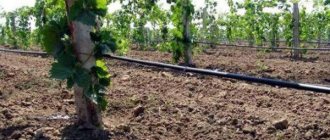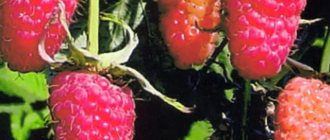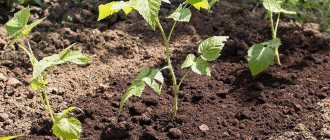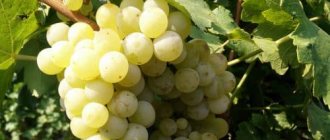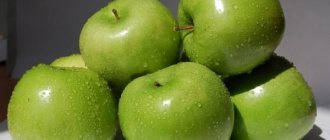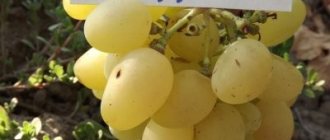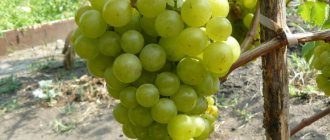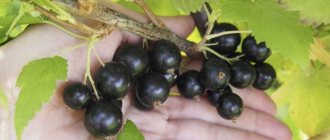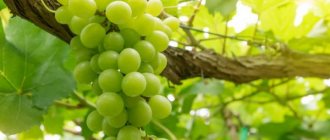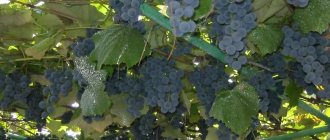Fruits and berries » Grapes
0
1066
Article rating
Kira Stoletova
The Pearl Sabo grape has several other names. It's different in every country. A distinctive feature of this variety is that it gives high yields, regardless of the region of growth.
Description of the Pearl Sabo grapes
The history of this grape
It was not without reason that this white muscat varietal table grape was bred in Hungary. This country has been famous for several centuries for its vineyards, from which high-quality table wine is made, including from Muscat grape varieties.
This hybrid appeared in a small town in the southeastern part of Hungary - in Bekes Csaba. Therefore, one part of the variety's name appeared as a reminder of the city where this vineyard was bred. And the color of its berries gave it a second name - Pearl or Pearl.
In our country, descriptions of the beginning of its cultivation have been found since the beginning of the last century, and its name has been transformed into the Russian way - Zhemchug Sabo or White Pearl.
It often happens that the same variety has many different names. This creates confusion, but is an unavoidable fact. When registering a new variety, the name of the vineyard is given by the breeder who developed it. And winegrowers very often give this grape their name (based on personal opinion).
Sometimes familiar names may be replaced by more spectacular ones for commercial purposes to emphasize the special origin of the variety.
The supposed "parents" of this vineyard.
- Hungarian Muscat is a vineyard with a high percentage of sugar in the fruit and a muscat aroma, growing in Mediterranean countries.
- Muscat Ottonel is the presumed variety that Stark used in the process of creating a new type of vineyard.
Leading breeders of our country have been actively working with seedlings of this variety for many years. The result of their work was new hybrids that were specially adapted to the conditions of various regions of our country (in particular, many regions of Siberia).
The Muscat Ottonel grape is a likely ancestor of the Sabo Pearl
Pests and diseases
The description of the Pearl Sabo grape variety indicates that the variety has a low immune system, and is therefore often affected by powdery mildew, fruit rot and fusarium.
- There is no effective remedy against powdery mildew. The entire plant will have to be eradicated.
- A solution of colloidal salt (3 g per 10 liters of water) will help get rid of fruit rot.
- In the fight against fusarium, a manganese solution (5 g per 10 liters of water) will come to the rescue.
Pests include codling moth and moth. It is worth fighting the codling moth with a solution of Bordeaux mixture (4 g per 10 liters of water). A tincture of garlic or onion (300 ml of garlic or onion juice per 10 liters of water) will help destroy midges. As a preventive measure against pests and diseases, spray with copper sulfate (50 g per 10 liters of water).
Pearls have always fascinated people with the beauty of luminous mother-of-pearl and the mystery of their appearance between the valves of sea mollusks.
Read also: Lydia grapes photo description and characteristics
Earthly beauty - “teeth like pearls”, or sharpness of thought - “pearls of speech, pearls of wit” were compared with pearls (an obsolete form of the word).
It is not surprising that one of the varieties of table grapes, in confirmation of its value, was called “Pearls” or “Pearls”.
Early grape varieties
Among specialists involved in the cultivation of this plant, the Pearl Sabo variety is still considered the standard of early ripening. This Hungarian variety is more than 100 years old, and its fruits can be tasted already on the eightieth day after the buds open. Its distinctive features also include a pleasant musky taste and high fruitfulness.
The only drawback is the small size of the berries, which makes “Pearl Sabo” uncompetitive in comparison with other varieties that ripen quite early. However, many gardeners are happy to plant it on their plots in order to be able to enjoy delicious berries in the middle of summer.
In addition to Zhemchug Sabo, the definition of “early ripening grape varieties” includes Ekaro-35, ripening on the 88th day, Galahard - on the 89th day and Serafimovsky - on the 89th day. At the same time, it is known that gardeners continue to work on breeding faster-ripening grapes. In addition, the issue of obtaining frost-resistant options is relevant.
Among the domestic varieties, one can also note the very early table variety Donskoy agate, which ripens well even in cloudy weather and has a large, conical, somewhat loose bunch, consisting of large, almost black, round berries. Arcadia is one of the early ripening varieties. This is a table variety with medium-sized bushes and high yield. Its clusters are very large and dense, and the berries are white.
Technological characteristics.
Composition of the bunch,%: juice - 79, stems - 4, skin and dense parts of the pulp - 14.5, seeds - 2.5. Sugar content of juice is 14-18 g/100 ml, acidity is 6.5-8.5 g/l. The average load for tearing off berries is 375, for crushing them is 419. Tasting score is 7.6 points. Does not tolerate transportation well. The variety is valued for its very early ripening and high taste qualities of the berries. Pearl Saba grapes are used fresh.
Article on the topic: Aigeni sowing - grapes
© photo by S.I. Krasokhina
Discussion of the Pearl Saba grape variety on the forum.
Variety Harold: grape description
| Purpose of the variety | dining room |
| Acidity of the variety | 6.5 - 8.5 g/l |
| Sugar content of the variety | 14 — 18 % |
| Bunch shape | cylindrical |
| Bunch weight | 120 g |
| Berries shape | rounded |
| Berry color | golden green |
| Berry size | up to 2 cm |
| Weight 100 berries | up to 117 g |
| Taste | pleasant with a noticeable nutmeg aroma |
| Ripening period | 115 days |
| Frost resistance | up to -27 оС |
| Productivity per hectare | 60 - 120 centners |
- A distinctive feature of the Pearl Saba variety is its very early ripening. The first harvests ripen in late July - early August. The full ripening cycle does not exceed 115 days.
- The variety prefers light loamy or chernozem soils. Tolerant to drought, but responds well to balanced irrigation. Grows best in moist, ventilated areas.
- The grapes of this variety do not have high growth vigor. The plant is medium-sized. Hence the small size of the bush and low yields. The average yield is 60-90 c/ha. The description of the variety indicates the maximum possible yield - 120 c/ha.
- Saba pearls produce medium-loose, loose clusters of small size. The shape of the clusters resembles the outline of a cylinder. In length - no more than 17 cm. At the base there is a long herbaceous comb, 4 cm in size, in rare cases capable of lignification. The mass of the bunch almost does not exceed 120 g.
- When pouring, the berries of this variety acquire a golden-green color. A thin, whitish, easily erasable wax coating appears on their surface. The very thin skin of the berries is not resistant to cracking, which during heavy rains leads to damage to the crop. The berries are medium size, round in shape. The size does not exceed 2 cm. Each berry has 1-2 small seeds. The description of the variety contains information about the average weight of 100 berries. This value does not exceed 117 g. As the berries ripen, they gain sugar and lose acid. In the mature form, the sugar content is 14-18%, acidity is 6.5 - 8.5 g/l. Overripe berries take on a reddish tint. The harvest must be harvested without waiting for this stage of maturity. Overripe berries acquire an unpleasant taste.
- Despite the presence of a bisexual flower, this variety has a tendency to pea.
- The leaves of the plant have distinctive features. On young seedlings they are very small and practically not dissected. The first two leaves are characteristically colored bronzed red. An adult plant has leaves of medium size, five-lobed with small dissections. On the inside of young leaves there is a delicate cobwebby coating. Mature leaves have slightly noticeable bristly pubescence. The leaf blade has a characteristic bend directed towards one of the blades.
- The description indicates good ripening of last year's shoots. Over the course of a year, the vine can lignify by 80-85%. A mature shoot is light brown in color with dark-colored internodes.
- Due to the early ripening period, Saba Pearl does not have time to be affected by gray rot. Regular treatment is necessary against fungal diseases of grapes. Resistance to mildew is average. There is a high susceptibility to oidium. Grapes of this variety are often affected by spider mites and necessarily require special treatment. Spider mites attack leaves. And the lack of green mass leads to the fact that the plant cannot provide itself with nutrients and grow a full-fledged crop.
- Ripe berries attract the attention of insects and birds. Without protection, the bunches are damaged and lose their consumer properties.
- Compared to other table varieties, this one is characterized by increased frost resistance. Which makes it possible to grow it in the northern regions. Stability limits are at -27°C.
Read more: Turkish Takla pigeons: photo, description of the breed
Extra early, 5 g, light golden, sweet nutmeg taste
Ultra-early ripening period 100-105 days, eaten at the end of July. Medium-sized fruits, 4-5 grams, round, light green in color, when ripening they acquire a golden or pinkish hue. The skin is thin, easily separated from the pulp. The taste is soft, balanced, accompanied by a nutmeg aroma. Medium sized bunch, 500 grams.
IMPORTANT! This variety is winter-hardy. In the conditions of Western and Eastern Siberia, grapes winter well under natural snow cover. However, during the period of snow melting, the Siberian region is characterized by recurrent frosts. This can lead to freezing of the buds and the death of the vine completely. For this reason, grapes must be covered for the winter. This way, your plants will be under reliable protection.
In our nursery, you can buy seedlings of the fruit grape Zhemchug Sabo on open trading floors and in nursery stores. For addresses, opening hours, and phone numbers of retail outlets, see the “Contacts” section (in the top menu).
Grapes are a fairly old plant shrub, which is mentioned in many myths and tales. In order to obtain a drink, such as wine, renowned throughout time, countless varieties were developed and grown in different regions and districts. In addition, the vineyards are famous for their taste, medicinal properties and variety of varieties. One of the universal varieties is the pearl grape; it is worthy of the attention of every gardener and ordinary gardening enthusiast.
Grapes Zhemchug - a universal variety
A powerful bunch of sweet table grapes can decorate any table and at the same time will leave few people indifferent. The emergence of breeding varieties makes it possible to grow this plant even in the northern regions of the country, under very short summer conditions. One of the hybrid varieties that has proven itself well is the Harold grape. Reviews indicate a stable harvest and high taste qualities of this variety.
When growing grapes for themselves, and not for sale, people are guided by the criteria of high yield, disease resistance and taste. Whereas for the market, the size and shape of the berries and the appearance of the bunch itself are important. But Harold grapes meet all of the above criteria. The description of the variety should begin with the fact that it has early ripening periods.
The clusters hanging on the bushes for a long time, until mid-September, are very similar to Harold grapes. Reviews from winegrowers indicate that with such storage, the grapes do not dry out, do not fall off, are not damaged by wasps, and the presentation and taste do not deteriorate.
The bushes of this variety are vigorous. Harold grapes have a medium-sized bunch weighing 400-500 grams, its shape is cylindrical-conical. The berries have an interesting elliptical shape with a pointed end. They are located quite tightly in relation to each other. The pulp of the berries is juicy, the skin is dense, yellow-green in color.
The Harold grape variety has a balanced sweet and sour taste and a pronounced Muscat aroma, which allows winemakers to use it to make Muscat wine.
Another feature of this variety is the need to normalize the inflorescences, since the grapes are prone to overload with the harvest, which can cause unripe bunches or even a deterioration in the quantity of the harvest.
In addition to shelter, some winegrowers also generously sprinkle the vines with soil. But before you lay the shoots on the ground, you should definitely lay something down so that the process of rotting does not begin.
Pruning a plant allows you to shape it, control growth, quantity and quality of the harvest. Before pruning, the condition of the bush must be assessed, and Harold, being a vigorous bush, feels good with any type of pruning, be it short, medium or long.
The seedling was planted in fertilized soil, so it will not need fertilizer for the first four years. Mature bushes most need mineral fertilizers, which must be applied annually before removing the cover from the bush and before flowering begins. Mature bushes will respond well to the entire range of mineral fertilizers, that is, nitrogen, phosphate, and potassium. They are added dissolved in ten liters of water (superphosphate, ammonium nitrate, potassium salt in proportions 2:1:0.5, respectively).
Before the brushes ripen, the bushes can be fed only with ammonium nitrate. If you feed before the onset of winter, it is better to use potassium. Organic fertilizers should be applied no more than once every few years. Poultry droppings, compost, rotted manure and other agricultural products are suitable as organic matter.
The crown of the young shoot is light green or yellowish-green with wine-red leaf tips. The first and second leaves have a bronze-reddish tint. The pubescence on the lower surface is cobwebby, on older leaves it is sparse, bristly, mainly on the veins. One-year-old mature shoot is light brown, the nodes are dark brown.
The leaf is medium-sized, slightly dissected, five-lobed, wavy. The upper and lower cuts are small, open, and slit-like. The petiole notch is usually open, vaulted, with an elliptical opening. The teeth at the ends of the blades are triangular. The denticles along the edge of the leaf are triangular, with convex sides. The pubescence of the lower surface of the leaf is weak and bristly.
The flower is bisexual. The cluster is of medium size, cylindrical-conical or conical (12-17 cm long, 8-10 cm wide), relatively loose or of medium density. The stem of the bunch is medium (4 cm long), herbaceous, sometimes woody. The mass of the bunch is 117 g. The berry is medium-sized (17-18 mm long, 18-19 mm wide), round, yellowish-green.
The leading characteristics of the Zhemchug Saba grape variety: small, almost whole leaves with a peculiarly curved plate (a part of the leaf is raised against one of the side notches); medium-sized bunches, with light green, very early-ripening berries; subtle nutmeg flavor.
Hybrid forms
As in the nature of pearls, grapes with this name come in white, pink and black. These are all new hybrid forms bred to improve parental characteristics.
Read also: Rose artemis encyclopedia of roses
- Grape Pink Pearl.
This species is the result of selection by specialists from the Research Institute of the Academy of Agricultural Sciences from Michurinsk.
This is an early ripening hybrid form of “Saba Pearl” that has spread throughout the country. The main advantage of the new hybrid is: increased winter hardiness down to -30°C and reduced vulnerability to fungal diseases, versatility of purpose.
Features: characterized by medium growth vigor and early fruit ripening (120 days). The fruiting efficiency of shoots is 85%. The optimal load is 45 eyes, the pink color of the berries was the reason for choosing the existing variety name.
The original taste and quality of the skin make the grapes a standard representative of the group of table varieties, sugar content up to 26%, acidity up to 9g/l. The average yield is 100 kg/ha, the yield increases with each year of the plant’s life, reaching a maximum in the 5th year. The weight of the bunch reaches 0.5 kg, young shoots ripen well for fruiting. The hybrid can overwinter directly on trellises, surviving a drop in temperature to -40°C.
Transportability of fruits has been improved. Instilled resistance to major grape diseases. Used for fresh consumption, production of juices and light wines.
Among the varieties used for wine production are also Saperavi, Riesling and Montepulciano.
Differences are visible in the shape of a large leaf (deeply dissected), in the size of the berries, reaching a weight of 5g, and in the color of the skin and pulp - light green. Fruiting efficiency is 78%, high yield (up to 150 c/ha).
The shape of the brush is conical, the weight of the brushes is up to 300 grams, the acceptable load on the bush is 30 eyes. It belongs to the covering types of grapes and has low resistance to diseases. Grapes Black Pearl . This variety is a technical selection of VNIIViV named after. Potapenko. Parents: a hybrid of the Amur and Augusta varieties, a hybrid of Levokumsky and “Centaur Magarachsky”. Registered in the State Register in 2005.
Features: strong growth of the bush, formed on two shoulders with a trunk height of 1 meter. The rooting rate of cuttings is high.
Early and medium ripening, yield up to 130 c/ha. The optimal load on the bush is 17 eyes, a dense bunch is complemented by wings. The fleshy berries are slightly oval, dark blue in color, with colorless pulp; belonging to the Muscat variety is manifested in a persistent aroma.
The accumulation of sugar is high (up to 24%), acidity - 7g/l, the assessment of the taste of table wine on a tasting scale is 7.6, aged dessert brands - 9.0. Damage to mildew - 2 points, winter hardiness -26°C.
Disadvantages of the White Pearl Vineyard
A description of the White Pearl variety would be incomplete without mentioning its shortcomings. Although there are few of them, they must be listed:
- the fruits of this vineyard are characterized by low transportability; if the ripe bunches are not picked from the bushes in time, they will lose their taste;
- at high humidity, the fruits crack and the juice leaks out;
- due to the low density of the skin, ripening berries are accessible to sparrows;
- low bushes cannot be used to decorate gazebos;
- other pests that are dangerous for this variety are wasps and spider mites;
- it should be carefully covered before the onset of winter;
- if the vines are overloaded, the berries in the clusters become smaller;
- non-simultaneous ripening of the crop.
A description of the White Pearl vineyard would be incomplete without mentioning that it is demanding on soil fertility. With timely application of fertilizers, the power of the vines increases and the quality of the fruit improves.
It is recommended to grow this vineyard in the North Caucasus, as well as in the Lower Volga.
Read more: The best varieties of roses that bloom all summer
Despite the popular belief that white wines can only be made from green or yellowish-green berries, such drinks can also be made from pink or red grapes. The fact is that, regardless of the color of the skin of the fruit, there is colorless juice inside them. However, white wines are usually sweeter and lighter than red wines, and have a lower strength. The main feature of the production of such drinks is the organization of fermentation of grape juice in the absence of berry skins.
Experts believe that the best grape varieties (white) are grown in France. In particular, the already mentioned Chardonnay variety is recognized as their queen. White Chardonnay wines are also produced today in California, Australia, Italy, Argentina, Germany, South Africa, Austria, Chile and New Zealand. In order to get the original oak flavor, they are aged in special large oak barrels.
In this case, you get an expensive elite drink. As for mass production, they use simple oak barrels or add oak chips and even special essence. Obviously, in such cases there can be no question of obtaining truly high-quality wine that will appeal to true connoisseurs.
When considering white grape varieties, it is impossible not to mention German Riesling. It has been noted that the most delicious wines are obtained from berries grown in the Moselle River basin in Germany. In addition, there are excellent vineyards in the Alsace region of France, and this variety is also cultivated in Hungary, Austria, Argentina and the USA.
The history of the white Muscat grape variety goes back to the times when Egypt was ruled by the pharaohs. Some researchers even associate its creation with the name of Cleopatra, which is completely unfounded, since it has been proven that it existed several centuries before the reign of this queen. Today Muscat is cultivated throughout the world, including South Africa and Australia.
As you can see, over many millennia of their history, people have been able to improve the grapes that, according to ancient Greek legend, were given to mortals by the Olympian gods, and have learned to create excellent wines from them. By the way, it is believed that the level of development of a country and people can even be judged by the culture of drinking wine.
White pearls are early varieties; the fruit berries ripen in four months. This variety can be characterized by high early maturity. White pearls are resistant to frost and disease, resistant to pests, and require virtually no chemical treatments. The resistance of the variety can be assessed as three points.
Description: the white pearl variety has small clusters, but quite dense with a total weight of up to two hundred grams. At first, the grapes are light green in color; as they ripen, the berries become dark green with a yellow tint. One berry can weigh up to five grams and has a unique, pleasant, sweet and very juicy taste. It has a high yield, ripening at least 80%.
White Pearl grapes - an extremely productive variety
Spider mite protection
When attacked by spider mites, the plant loses the functionality of the leaves as a mechanism for photosynthesis. Parasites suck out the juices of the shoots and poison them with the poison of their saliva.
The structure of the plant is deformed, the leaves curl and fall off. Accomplices of pests are the plants of the main house - weeds, from which they move to the vineyards, and hot, dry weather.
The following are equally dangerous for grapes:
Control measures:
- Attracting natural enemies of mites: lady beetles, flower bugs.
- Mowing the vineyard to remove weeds.
- Treatment of bushes before the beginning of the growing season and 2 weeks after - nitrophen, rogor, fozalon, etc. with alternating fungicides to avoid persistent addiction among mites.
- Trimming and burning heavily infected areas of bark.
30 species of mites can cause damage to a vineyard. What they have in common is a large clutch of eggs on the bark near the nodes. Therefore, bushes must be regularly inspected to identify parasites.
We also recommend that you familiarize yourself with the signs and features of the prevention of such common grape diseases as anthracnose, chlorosis, bacteriosis, mildew and oidium, and bacterial cancer. You can read about them in detail in separate materials on the site.
All grape varieties with the word “pearl” in their name will definitely add to your treasure trove of plants in the garden, no matter the size.
If you find an error, please select a piece of text and press Ctrl+Enter.
The grape called “Szabo Pearl” was bred at the beginning of the last century by the Hungarian breeder Stark. But there is no description of which varieties were crossed. This table grape has many names - Perla Chabanska, Perl de Csaba, Muscat Xaba, Perl de Saba, Muscat Pearl Csaba, Csaba gengi, Stark Seedling. In different countries where it has been grown for centuries, the Pearl Sabo grape has its own name, but we are talking about the same variety.
The Pearl Sabo grape is a Hungarian variety with more than a hundred years of history.
Sabo pearls are grown in the Mediterranean countries of Europe, and even in some areas of North Africa. In Russia, this variety has taken root in the south - in the Krasnodar Territory, Volgograd and some other regions with a warm climate.
Read also: Transplanting indoor flowers in September 2018
Best places to land
The middle zone of our country does not belong to the regions where viticulture was traditionally practiced, although there is information about its cultivation back in the days of Kievan Rus. At the same time, thanks to the constant breeding activities of Russian gardeners, varieties have been developed that have taken root well here and allow us to enjoy delicious grapes already at the beginning of autumn.
If you read the reviews, the Kesha grape variety, or, as it is also called, Talisman, is the best choice. This is a bisexual variety. There is also its variant Kesha-1 with exclusively female flowers. This variety is characterized by high productivity and has vigorous bushes. The clusters of Keshi are dense, conical, large, while those of Keshi-1 are loose. They have large, white, oval, very tasty, fleshy, juicy berries.
In addition, in Russian climatic conditions, good results can be achieved by growing the following varieties:
- American variety Valiant. It is vigorous and exhibits good resistance to low temperatures and has dark blue and blue berries. At the same time, the sugar content in fruits can reach 20 percent. In addition, Valiant is suitable for beautifying garden areas, as it is an excellent choice for landscaping hedges and garden arbors.
- Augustine is a table variety that belongs to the category of early ripening varieties. This is a very unpretentious, reliable and high-yielding variety. Its clusters can be stored without picking them from the bushes for 20 days. The cluster of the Augustina variety is conical, large, of medium density, consisting of large, elongated white berries that have a harmonious taste and are slightly translucent in the sun. Suitable for decorating hedges and garden gazebos.
- Grapes prefer well-lit places, otherwise the berries may not be sweet, the yield will be significantly reduced, and the winter hardiness of the bush will be reduced.
- Fruit vineyards of pearls must be carefully protected from the winds. Impeccable protection is provided by brick walls on the southern sides of the house, which can not only protect the bushes from the breeze, but also warm the vines.
- This type of grape does not like large accumulations of water. Therefore, if groundwater is observed at the site, drainage should be organized. This will help avoid rotting of the root system of the bush.
- Sandy or loamy soils with neutral acids are suitable for these grape varieties. The composition of a different soil may lead to inhibited development of the vineyard, which will lead to further death.
Description of the decrease in soil acidity. It is necessary to add lime in the following varieties: dolomite flour, calcareous tuff, marl, wood ash and chalk. Slaked lime is suitable as a fertilizer, but it should be used with extreme caution. It is a powerful alkali; it is necessary to fertilize the soil with it five days before planting grape vines in order to avoid burning the root systems.
Fertilizer in the form of lime is sufficient to apply once every six years. The approximate dosage for 11-12 sq.m of clay soil is 7-11 kg of lime, and for sandy soil a sufficient amount for the same size is 1-3 kg of lime, applied once every two years.
The vineyard should be well lit
Fruit pearls can be planted in two ways.
First description: planting pearl grape varieties on a hill. If the shrub grows on a hill and the soil warms up well, then this variety will begin the early growing season and provide the gardener with a high yield. To plant grapes, the soil should be carefully prepared. Create a hole no more than fifty centimeters deep, provide the bottom with drainage, then fill it with fertile soil.
Next, build a hill with a gentle slope of 15-27 centimeters and plant the required grape variety. If the vine is planted on a slope, then covering it before winter will be easier and more convenient.
Second description: planting pearl grapes in a hole. The root system of the seedling will be more reliably protected from frost, especially if there is no snow in the winter. Plant your favorite variety of pearls in a hole, the depth of which will be at least 65 centimeters. When planting, deepen the seedling by 6-9 centimeters, arrange a slight slope for convenient covering of the grapes, preparing for the winter period.
Grape planting scheme: mound of earth, ground level, support, layers of humus, compost, ash and crushed stone
Read more: Harold grapes - description of the variety with photos, reviews, proper care
The Harold fruit grape, or rather its annual seedling, should be shortened to four or five eyes before planting. A day or two before planting, the shoot is lowered into water, where it is advisable to add a growth stimulator.
Wine (technical) varieties
The most famous wine-producing regions of the world are the countries of the Mediterranean basin, Germany, Hungary and Chile. Georgian and Crimean wines are especially famous in the CIS, and wine grape varieties are also used to produce the famous Armenian cognac. Wines are also produced in Moldova. In addition, grapes for making wine have been grown in Australia for more than 150 years, where they were brought from Europe.
Among the most valuable and famous varieties are Aligote (Makhranuli), French Cabernet Sauvignon, also known as Lafite, White Kokur, bred in ancient times in Egypt, White Muscat, German Muller Thurgau, famous Georgian Rkatsiteli, French Chardonnay, Armenian 3000-year-old variety Mskhali and Hungarian Furmint are the main raw materials for the production of excellent Tokaji wines, for which Hungary is famous.
It has good yield; on average, more than 100 centners can be harvested from one hectare. Used for making table wines and juices.
French grape variety. Vigorous bushes with excellent shoot ripening. Productivity is high – 60-90 c/ha. Sweet berries, sugar percentage about 21%. Slight acidity – 9%. The crown is light green in young shoots, with slight pubescence. There are red edged teeth on the surface. Mature shoot with nut tones. The leaf is small, spherical, strongly dissected, with five lobes. The flower is functionally bisexual.
"Pino black"
The variety is moderately winter-hardy.
This variety is a complex hybrid of Amur, American and European varieties. Quite common in the Primorsky Territory. Ripening occurs in the second mid-September.
Slightly dissected, large, rounded leaf, with three lobes. There is slight pubescence on the lower part. Functionally, the flower is bisexual. The bunch of this variety is large, conical, loose and branched. The berries are medium-large, spherical, dark red in color. Juicy, watery pulp. Satisfactory ripening of shoots.
Once a week we will send to your email the best new materials from our site during this time. You can unsubscribe from the mailing list at any time! *but we promise we won't bother you??
Features you encounter when growing a variety
The benefits of grapes for the body are undeniable
The Sharov's Mystery grape variety is not whimsical. It can be easily grown even by novice winegrowers.
When choosing the area where you will plant the cutting, make sure that it ultimately receives as much sunlight as possible. This must be a place where there are no cold drafts. Also make sure that in this place there is minimal possibility of flooding the cutting.
The best option is if you plant the cuttings along the southern building. This variety is insensitive to soil fertility. This is because the shrubs develop a very well root system. The roots go to a depth of 10 meters.
Since the variety has been tested and studied for a long time, its description contains a full set of recommendations on agricultural technology.
Grape feeding
Pearl vineyard bushes should be fertilized in early spring. Horse manure mixed with water is suitable for this. Apply 8 liters of fertilizer to one bush; if the seedling is young, then three liters of fertilizer per bush is sufficient.
Water the grapes once every seven days. Approximate watering dosage is 20 liters of water for one adult bush. The most important and necessary watering is during the period of bud break, after the grapes have faded and when the berries are growing. There is no need to water the pearls before harvesting, otherwise the berries may crack and lose all their taste.
Do not water grapes with icy water from wells so that the bushes are not susceptible to fungal diseases. It is better to collect water in a container that will stand and warm up under the sun.
For better pollination of pearl grapes, plant several different shrubs on the plot, which will positively affect the high yield. Berries that are cross-pollinated have a better taste and their skin is softer. If the variety of pearls is different with different periods of formation, then the loss of fruits from frosty winters and other unfavorable circumstances will be minimal.
Sustainability.
Grapes are moderately affected by mildew and are sensitive to oidium. The variety is not affected by gray rot due to its very early ripening period. The leaves are severely damaged by spider mites. The berries are often damaged by birds, bees and wasps, so quick sale of the crop is required. The winter hardiness of the grape variety is slightly higher than that of other table varieties. Fruitful shoots can develop from replacement and dormant buds and allow partial restoration of the harvest. Pea peas are observed every year.
Mulching variety
In terms of its properties, mulch is similar to organic fertilizers, but performs a completely different function. It is necessary in order to retain moisture in the soil.
Suitable materials for mulch include peat, humus, straw, old fallen leaves or simply mown grass. Specialized stores offer a large selection of special materials that can protect plant roots from dehydration, prevent the development of weeds, and improve aeration.
Care instructions
This variety does not tolerate excessive watering.
Watering is carried out rarely, because the plant does not tolerate waterlogging of the soil. Water the bushes as the soil dries out. Each plant should have 20 liters of warm, settled water. After 2-3 days, the beds are weeded; it is worth uprooting the weeds, which are often parasitized by pests.
Pruning is carried out in spring and autumn. In spring, it is worth removing any tendrils and dry areas that have appeared. This will reduce the level of false ovaries. In autumn, excess eyes are removed. There should be no more than 8 of them. At this time, the crown is thinned out. After the grapes ripen, they should be picked immediately. If you leave them in this position for 5-7 days, the fruit will begin to rot. The bush is tied as it grows.
Before flowering, the crop is fed with potassium compounds (40 g per 10 liters of water). Before fruiting, water the plant with a solution of phosphorus fertilizers (50 g per 10 liters of water). If necessary, in the fall, mulch the soil with humus and straw to protect the roots from frost.
